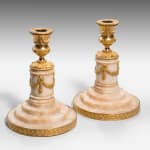Pair of Ormolu Mounted Nottinghamshire Alabaster Candlesticks by Matthew Boulton
ENGLAND, early 1770s
19 x 14.5 x 14.5 cm
Further images
A pair of candlesticks with ormolu swags on the pedestal, crowned with an ormolu candle nozzle. The pedestal and steps on this pair of candlesticks are made from Nottinghamshire alabaster, with a decorative ormolu band surrounding the base of each candlestick. The design corresponds to a sketch in Boulton and Fothergill’s Pattern Book I, page 171. The top of the nozzles are gadrooned, as in the drawing, which probably worked as an insert to hold the candle. In his book Matthew Boulton: Ormolu, Nicholas Goodison points out that the candlesticks share a number of features with other ornaments made in about 1770-71: the stepped bases which appear on the Lyre vase perfume burners; the swags on the pedestal which appear on the Cleopatra vases; and the candle nozzles which appear on the Candle vases housed in Temple Newsam and belonging to the City of Leeds Art Gallery (Nicholas Goodison, Matthew Boulton: Ormolu (Christie’s, 2002), p.184).
Goodison comments that: ‘there seems to have been little demand for ormolu candlesticks at any time, perhaps because they were expensive in relation to candlesticks made of silver plate, of which Boulton and Fothergill produced large numbers. Furthermore, only six identifiable designs for ormolu candlesticks have survived in the pattern books’ (Goodison, Matthew Boulton: Ormolu, p.184).
For a comparative candlestick by Boulton and Fothergill which is made from white marble and is thought to be one of a pair, dated c.1772-3, see Hotspur: Golden Jubilee 1924-1974 (Hotspur Limited, London, June 1974), plate 30 and Goodison, Matthew Boulton: Ormolu, figure 129.






